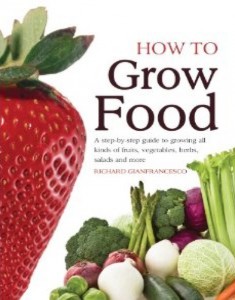REVIEW: A realist’s guide to the fruits of vegging out
There’s something telling about the media release that got sent out with How to Grow Food, a new book by Richard Gianfrancesco about harvesting your own vegetables and herbs in everything from kitchen flower pots to a mansion estate backyard.
to Grow Food, a new book by Richard Gianfrancesco about harvesting your own vegetables and herbs in everything from kitchen flower pots to a mansion estate backyard.
It states that 31 per cent of households participate, or desire to participate, in food gardening. It’s the “desire to participate” part that we need to think about.
The Velvet Underground had a song in 1970 when the back-to-the-land movement was in full-swing swing called Train Round the Bend, where Lou Reed sings from the point of view of a city boy turned farmer who’s quitting and waiting for a train to take him back to urban life.
“I’m sick of the trees, take me to the city! Train comin’ round the bend!” is how one verse went.
Now to be fair, Reed wasn’t a fan of rural life. In another one of his songs he claimed that the one good thing about a small town is “You know you want to get out.” But it’s important to recognize the message that something we think is a good and noble thing, like growing food, might not really be so great or easy when we try it.
Gianfrancesco is a plant scientist, and maybe even a realist. Right from the introduction he warns that growing your own food isn’t as labour-free as some promoters might have us believe. He’s also thoughful enough to warn that it isn’t always cost-saving, either.
(The suggested price for the hardcover, published by Firefly Books, is $29.95.)
“For many, growing fruit and vegetables can last just a single year, being put off by failure and a lack of time to keep your plot in order,” he writes.
It’s like he’s reading your mind.
You don’t need another lecture about how much better garden-grown tomatoes taste. And you’ve seen the documentaries about how ferilizers used by agri-busineeses are creating giant algae blooms and choking fish.
What you really need is a book that understands that you’re busy, and lays out the easiest ways to grow things.
The “how to’s” of How to Grow Food start off with types of gardens, such as backyard or balcony, and then move on to planning that garden with practical advice. Some of the advice you might think is common, such as making sure your balcony is sturdy enough to hold the weight of the pots of soil.
Other advice, like the fact that wind breaks need to be able to let some air pass through in order to prevent potentially-damaging vortexes, or even that trees suck up huge amounts of water and might make nearby soil dry, might be important news even for intermediate gardeners.
The largest section in the book is the growing directory with directions and advice for raising over 80 different crops ranging from potatoes and parsnip to kiwi and passion fruit. Of course, the pages on gowing citrus probaly won’t be useful in Edmonton, but it turns out that a surprising number of fruits and vegetables listed can indeed be grown here.
Once again, Gianfrancesco is reading our minds and warns us to keep our ambitions in check.
“Grow only those that are likely to succeed in the space you have and the time you can spend caring for your plants,” he states.
To help with this, the book offers “Star Plant” headings. Potatoes get a “Star Plant” heading for their high yield with a minimum of effort. Carrots get one for their ability to deliver high yields in a small space.
There’s even instructions on growing most items in flower pots, which theoretically means you can be a farmer without ever having to go outside. And at the end of the book, it tells you how to can, freeze or dry your bounty.
Perhaps you’re in that “desire to participate” demographic the press release talked about. Maybe you’ve even gone so far as to buy a spade and tore up some sods with the intention of planting a whole supermarket of veggies, only to forget to plant the seeds, forget to do the weeding, and forget that there were some episodes of HBO’s Boardwalk Empire you wanted to watch again.
Maybe, though, this could be your year.











